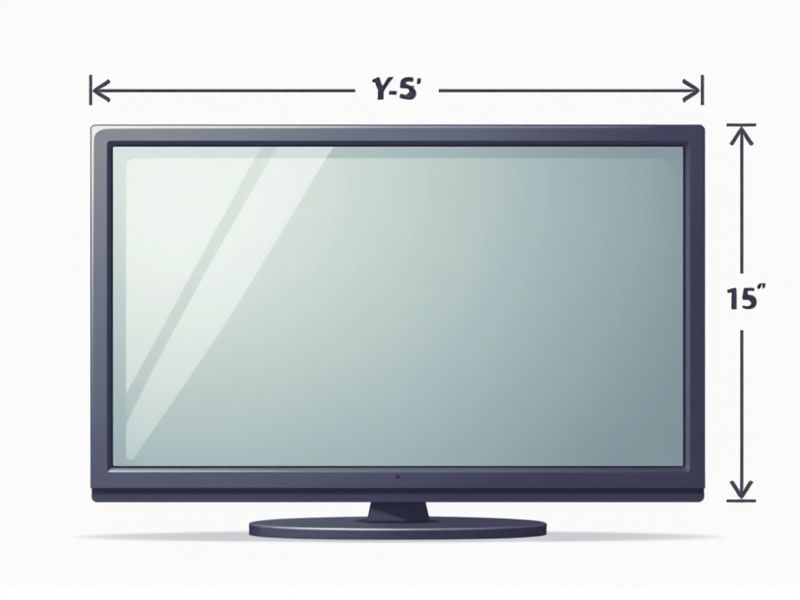
When selecting a television, it's helpful to understand standard dimensions measured in inches, which refer to the diagonal length of the screen. Common TV sizes include 32-inch, 43-inch, 55-inch, and 65-inch models, with widths and heights varying based on the aspect ratio--most modern TVs use a 16:9 ratio. For example, a 55-inch TV typically measures about 48 inches wide by 27 inches tall. Knowing these standard dimensions can help you choose a television that fits perfectly in your living space.
Aspect Ratio
The aspect ratio of a television significantly influences viewing experience, with common standards being 16:9 for HD and 4:3 for older models. A 16:9 aspect ratio caters to modern cinematic content and high-definition broadcasts, providing a wider field of view that enhances immersion. In contrast, the 4:3 aspect ratio is more suited for classic television shows and older films, making it crucial to consider when choosing a television for specific content preferences. Ensuring your TV matches the desired aspect ratio can improve picture quality and viewer satisfaction.
Screen Size
The standard screen size for televisions has evolved, with the most popular sizes ranging between 55 to 65 inches in 2023. Larger models, such as 75 inches or more, are gaining traction as home theater setups become more common. The ideal viewing distance for a 65-inch TV is approximately 8 to 10 feet, enhancing your overall experience. With advancements in 4K and 8K resolution, larger screens provide improved picture clarity and detail, making size an essential consideration for modern viewers.
Resolution
The standard resolution for modern televisions typically starts at 1080p, which offers 1,920 x 1,080 pixels, delivering a crisp and clear viewing experience. Many consumers are now shifting towards 4K Ultra HD, featuring a staggering 3,840 x 2,160 pixels, allowing for more detailed images and vibrant colors. The latest advancements have introduced 8K resolution, boasting a remarkable 7,680 x 4,320 pixels, though content availability remains limited. Investing in higher resolution TVs can significantly enhance your overall viewing experience, especially for large screen sizes.
Viewing Distance
The ideal viewing distance for a television largely depends on its screen size, contributing to an optimal viewing experience. For instance, the recommended distance is typically 1.5 to 2.5 times the diagonal screen size; if you own a 55-inch TV, your viewing distance should be between approximately 6.9 to 11.5 feet. This distance not only enhances picture clarity but also minimizes eye strain during prolonged viewing sessions. Understanding these guidelines can significantly improve your home theater experience, ensuring you enjoy your favorite shows with maximum comfort and detail.
Bezel Thickness
Bezel thickness significantly impacts the overall aesthetics and viewing experience of modern televisions. Leading brands, such as Samsung and LG, are now producing models with bezels as thin as 1 millimeter, creating a more immersive viewing environment. A thinner bezel not only enhances design appeal but also maximizes screen real estate, providing a more expansive visual experience. You can improve your home entertainment setup by choosing a TV with a minimal bezel, ensuring that the focus remains on the stunning content displayed.
Mounting Options
Television mounting options include wall mounts, ceiling mounts, and tabletop stands, with wall mounts being the most popular choice due to their space-saving benefits. A fixed mount typically holds audio-visual equipment flat against the wall, while tilt and full-motion mounts provide adjustable viewing angles. When selecting a mount, consider the weight capacity, typically ranging from 50 to 350 pounds, and ensure compatibility with the TV's VESA mount pattern, which is often 200x200mm to 800x600mm. For optimal viewing, the center of your TV should align approximately 42 inches from the floor, ensuring a comfortable eye level.
Frame Design
Frame design significantly influences television aesthetics and user experience, with contemporary models often featuring ultra-slim bezels measuring as little as 2mm. Leading brands, such as Samsung and LG, utilize cutting-edge technologies like OLED and QLED to enhance colors and contrast, improving visual fidelity. In 2023, the average screen size for consumer TVs reached around 65 inches, accommodating larger viewing areas while maintaining sleek profiles. You can personalize your setup by selecting a frame design that complements your home decor, offering options from minimalist styles to bold artistic statements.
Depth Profile
The depth profile of a standard television is a critical aspect, typically ranging from 1 to 4 inches, significantly affecting both aesthetic appeal and installation flexibility. This measurement influences how flush the television sits against the wall, enhancing the overall viewing experience. With advancements in technology, newer ultra-thin models boast a depth as slim as 1 inch, making them ideal for modern, minimalist living spaces. When selecting a TV, consider how its depth will complement your room's layout and your overall design vision.
Connectivity Ports
Modern televisions typically include an array of connectivity ports to enhance versatility and user experience. You might find HDMI ports, often ranging from two to four, which support high-definition audio and video transmission. Furthermore, USB ports, usually available in one or two configurations, enable multimedia playback and device charging. Other connections like Ethernet ports for internet access and optical audio outputs for superior sound quality round out the standard set of connectivity options, ensuring a seamless integration with various entertainment systems.
Weight
The standard weight range for modern televisions typically varies between 15 to 150 pounds, depending on screen size and technology. For instance, a 55-inch LED television can weigh around 40 to 50 pounds, while larger 75-inch OLED models may reach up to 100 pounds or more. It's crucial to consider the weight when choosing a mounting option or entertainment unit, as improper support can lead to significant safety risks. Ensuring the mount or surface can handle at least 1.5 times the television's weight is recommended for optimal stability.
